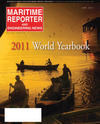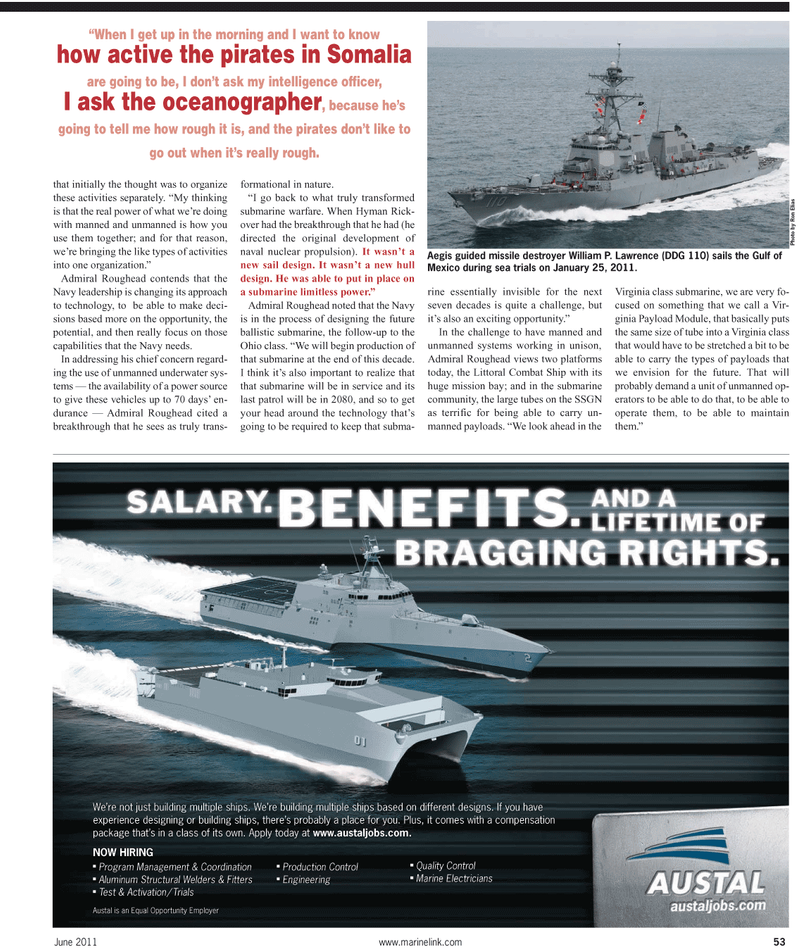
Page 57: of Maritime Reporter Magazine (June 2011)
Feature: Annual World Yearbook
Read this page in Pdf, Flash or Html5 edition of June 2011 Maritime Reporter Magazine
June 2011www.marinelink.com 53Were not just building multiple ships. Were building multiple ships based on different designs. If you have experience designing or building ships, theres probably a place for you. Plus, it comes with a compensation package thats in a class of its own. Apply today at www.austaljobs.com. g Program Management & Coordination g Aluminum Structural Welders & Fitters g Test & Activation/Trials g Production Control g EngineeringNOW HIRINGAustal is an Equal Opportunity Employer g Quality Control g Marine Electriciansthat initially the thought was to organize these activities separately. My thinking is that the real power of what were doing with manned and unmanned is how you use them together; and for that reason,were bringing the like types of activities into one organization.? Admiral Roughead contends that theNavy leadership is changing its approach to technology, to be able to make deci- sions based more on the opportunity, the potential, and then really focus on thosecapabilities that the Navy needs. In addressing his chief concern regard- ing the use of unmanned underwater sys- tems ? the availability of a power source to give these vehicles up to 70 days en- durance ? Admiral Roughead cited a breakthrough that he sees as truly trans-formational in nature.I go back to what truly transformedsubmarine warfare. When Hyman Rick- over had the breakthrough that he had (he directed the original development of naval nuclear propulsion). It wasnt anew sail design. It wasnt a new hulldesign. He was able to put in place ona submarine limitless power.? Admiral Roughead noted that the Navy is in the process of designing the futureballistic submarine, the follow-up to the Ohio class. We will begin production of that submarine at the end of this decade.I think its also important to realize that that submarine will be in service and itslast patrol will be in 2080, and so to getyour head around the technology thats going to be required to keep that subma- rine essentially invisible for the next seven decades is quite a challenge, but its also an exciting opportunity.? In the challenge to have manned and unmanned systems working in unison, Admiral Roughead views two platforms today, the Littoral Combat Ship with its huge mission bay; and in the submarinecommunity, the large tubes on the SSGN as terrific for being able to carry un- manned payloads. We look ahead in the Virginia class submarine, we are very fo- cused on something that we call a Vir- ginia Payload Module, that basically puts the same size of tube into a Virginia class that would have to be stretched a bit to be able to carry the types of payloads thatwe envision for the future. That will probably demand a unit of unmanned op-erators to be able to do that, to be able tooperate them, to be able to maintainthem.? When I get up in the morning and I want to know how active the pirates in Somaliaare going to be, I dont ask my intelligence officer, I ask the oceanographer, because hes going to tell me how rough it is, and the pirates dont like to go out when its really rough. Aegis guided missile destroyer William P. Lawrence (DDG 110) sails the Gulf of Mexico during sea trials on January 25, 2011.Photo by Ron Elias

 56
56

 58
58
